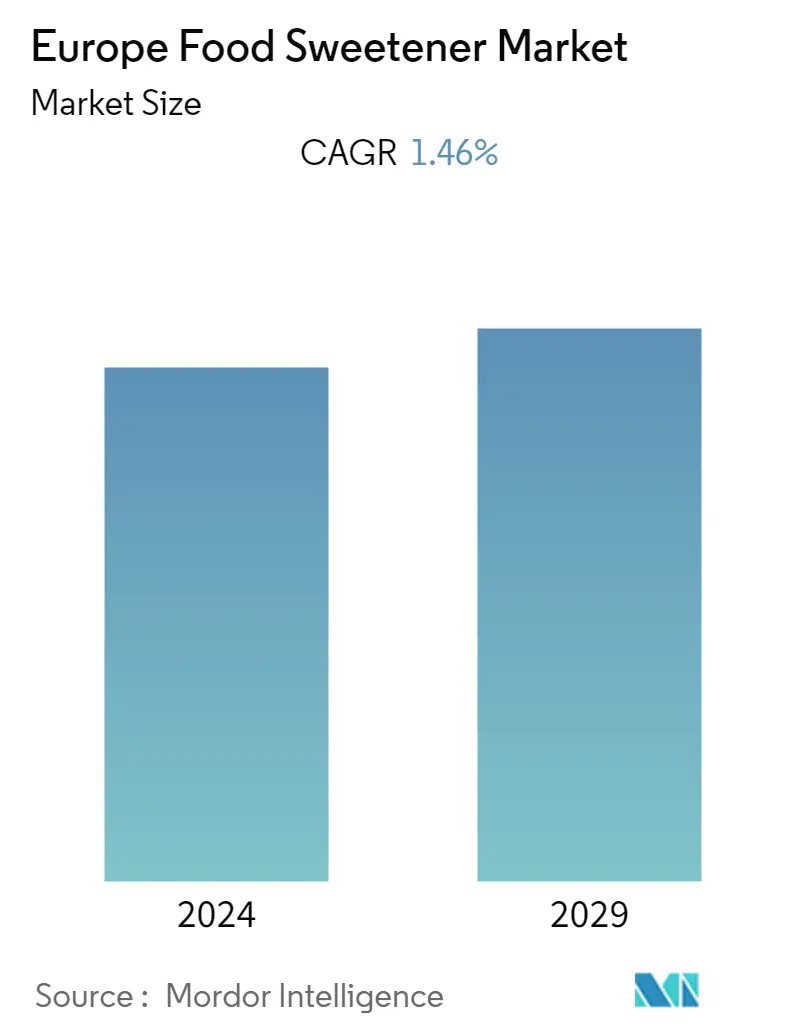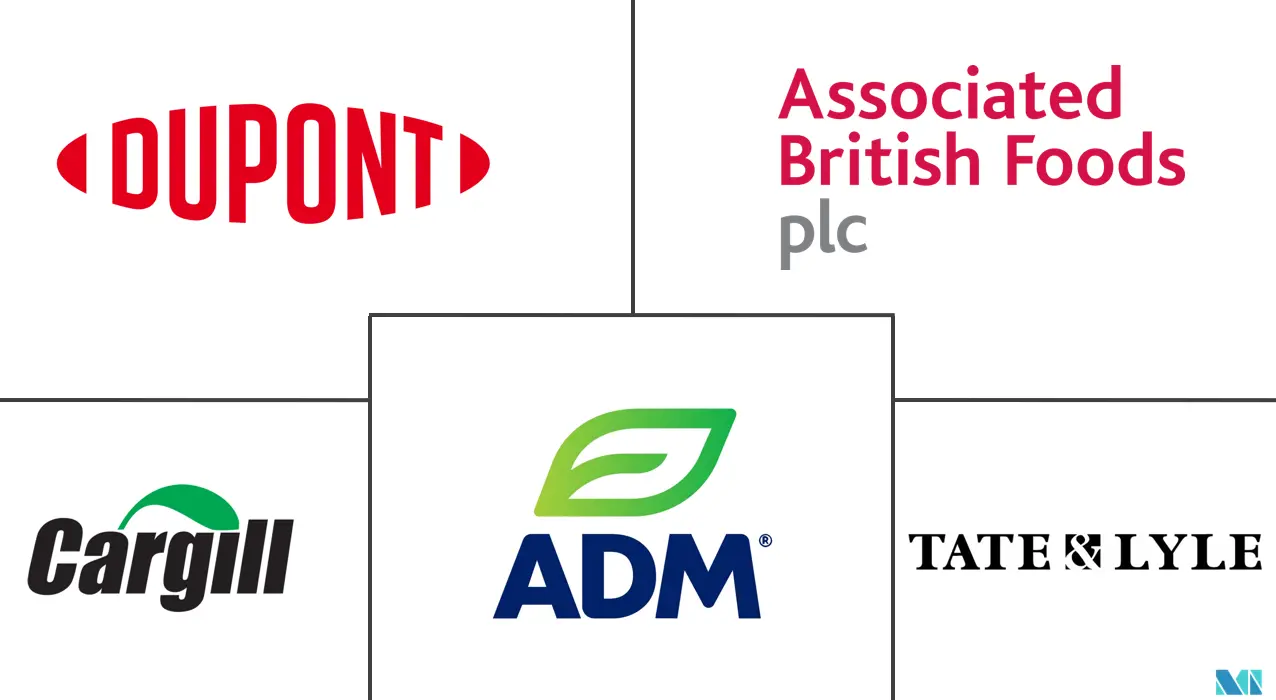Market Size of Europe Food Sweetener Industry

| Study Period | 2019 - 2029 |
| Base Year For Estimation | 2023 |
| Forecast Data Period | 2024 - 2029 |
| Historical Data Period | 2019 - 2022 |
| CAGR | 1.46 % |
| Market Concentration | Low |
Major Players
*Disclaimer: Major Players sorted in no particular order |
Need a report that reflects how COVID-19 has impacted this market and its growth?
Europe Food Sweetener Market Analysis
Over the next five years, the food sweetener market in Europe is expected to grow at a CAGR of 1.46 %.
Consumers these days are becoming more aware of their food consumption and the ingredients in it. Most consumers prefer plant-based ingredients in their food. To meet market demand, market players have been launching plant-based ingredients, such as plant-based sweeteners. Due to the rise in disposable income, increased working population, and busy lifestyles, the consumption of processed foods and beverages is increasing. Additionally, the region's demand for food sweeteners is increasing due to increased convenience food and processed food consumption. The use of food sweeteners in processed food increases its taste without adding any calories, which is why its demand is increasing in the region.
Currently, the consumption of sugar substitutes is increasing rapidly in Europe. This is attributed to consumer awareness, government regulation to reduce sugar consumption, and the application of this concept in many health and wellness food products on the market. The other major reason for the growth of sugar substitutes is the increasing population of obese, overweight, and diabetic patients in Europe. According to the British Diabetic Association's data from 2021, around 1.4 million people in the United Kingdom live with diabetes. Most of the market leaders are bringing innovative products, especially stevia-derived products, to meet the growing consumer demand for non-caloric natural sweeteners in both food and beverages.
Europe Food Sweetener Industry Segmentation
Food sweeteners are substances that are added to food to impart a sweet taste. The sweeteners can be natural or artificial. Type, application, and country segments make up Europe's food sweetener market. By type, the market is segmented into sucrose, starch sweeteners, sugar alcohols, and high-intensity sweeteners (HIS). Starch sweeteners and sugar alcohols are sub-segmented into dextrose, HFCS, maltodextrin, sorbitol, and other starch sweeteners and sugar alcohols. The high-intensity sweeteners (HIS) are further sub-segmented into sucralose, aspartame, saccharin, neotame, stevia, cyclamate, acesulfame potassium (Ace-K), and others. By application, the market is segmented into bakery and confectionery, dairy and desserts, meat and meat products, soups, sauces, dressings, and other applications. By geography, the market is segmented into the United Kingdom, Germany, France, Spain, Italy, Russia, and the Rest of Europe. For each segment, market sizing and forecasting have been done based on value (USD million).
| Product Type | ||||||||||
| Sucrose | ||||||||||
| ||||||||||
|
| Application | |
| Dairy | |
| Bakery | |
| Soups, Sauces and Dressings | |
| Confectionery | |
| Beverages | |
| Other Applications |
| Geography | |
| United Kingdom | |
| Germany | |
| France | |
| Spain | |
| Italy | |
| Russia | |
| Rest of Europe |
Europe Food Sweetener Market Size Summary
The European food sweeteners market is poised for steady growth over the next five years, driven by a shift in consumer preferences towards plant-based and natural ingredients. As awareness of health and nutrition increases, consumers are increasingly opting for sweeteners derived from organic sources like stevia and xylitol, which offer the sweetness of sugar without the associated calories. This trend is further fueled by the rising consumption of processed and convenience foods, attributed to higher disposable incomes and a busy lifestyle among the working population. The demand for sugar substitutes is also on the rise, supported by government regulations aimed at reducing sugar intake and the growing prevalence of health issues such as obesity and diabetes across the region.
The market is characterized by the presence of several key players, including Cargill, Inc., Tate & Lyle, and Archer Daniels Midland Company, who are actively engaging in product innovation and strategic partnerships to meet the evolving consumer demands. These companies are focusing on developing low-calorie sweeteners and expanding their product portfolios to include new offerings like stevia-based sweeteners and erythritol. The increasing import of natural sweeteners, such as stevia, highlights the growing demand for these products in Europe. As the market continues to evolve, the emphasis on health-conscious and natural food ingredients is expected to drive further growth in the European food sweeteners industry.
Europe Food Sweetener Market Size - Table of Contents
-
1. MARKET DYNAMICS
-
1.1 Market Drivers
-
1.2 Market Restraints
-
1.3 Porter's Five Forces Analysis
-
1.3.1 Threat of New Entrants
-
1.3.2 Bargaining Power of Buyers/Consumers
-
1.3.3 Bargaining Power of Suppliers
-
1.3.4 Threat of Substitute Products
-
1.3.5 Intensity of Competitive Rivalry
-
-
-
2. MARKET SEGMENTATION
-
2.1 Product Type
-
2.1.1 Sucrose
-
2.1.2 Starch Sweeteners and Sugar Alcohols
-
2.1.2.1 Dextrose
-
2.1.2.2 High Fructose Corn Syrup (HFCS)
-
2.1.2.3 Maltodextrin
-
2.1.2.4 Sorbitol
-
2.1.2.5 Xylitol
-
2.1.2.6 Other Product Types
-
-
2.1.3 High Intensity Sweeteners (HIS)
-
2.1.3.1 Sucralose
-
2.1.3.2 Aspartame
-
2.1.3.3 Saccharin
-
2.1.3.4 Cyclamate
-
2.1.3.5 Ace-K
-
2.1.3.6 Neotame
-
2.1.3.7 Stevia
-
2.1.3.8 Other High Intensity Sweeteners (HIS)
-
-
-
2.2 Application
-
2.2.1 Dairy
-
2.2.2 Bakery
-
2.2.3 Soups, Sauces and Dressings
-
2.2.4 Confectionery
-
2.2.5 Beverages
-
2.2.6 Other Applications
-
-
2.3 Geography
-
2.3.1 United Kingdom
-
2.3.2 Germany
-
2.3.3 France
-
2.3.4 Spain
-
2.3.5 Italy
-
2.3.6 Russia
-
2.3.7 Rest of Europe
-
-
Europe Food Sweetener Market Size FAQs
What is the current Europe Food Sweetener Market size?
The Europe Food Sweetener Market is projected to register a CAGR of 1.46% during the forecast period (2024-2029)
Who are the key players in Europe Food Sweetener Market?
Cargill, Incorporated, Tate & Lyle, Archer Daniels Midland Company, DuPont de Nemours Inc. and Associated British Foods Plc are the major companies operating in the Europe Food Sweetener Market.

